Green nanoarchitectonics of the silver nanocrystal potential for treating malaria and their cytotoxic effects on the kidney Vero cell line
-
Abdullah F. Shater
Abstract
This study focused on testing manufactured silver nanoparticles (AgNPs) against the malaria pathogen Plasmodium falciparum and the malaria vector Anopheles stephensi using the plant filtrate from Madhuca longifolia. The M. longifolia leaf extracts were used to synthesize the AgNPs, which were then subjected to several physicochemical methods to determine their characteristics. To evaluate the effectiveness of the green produced AgNP therapy, the mosquitocidal activity of A. stephensi, cytotoxicity assay in Vero cells, and antiplasmodial activity assay were performed. The larval and pupal toxicity of biosynthesized AgNPs against the malarial vector A. stephensi is 90% promising in laboratory settings at low dosages (10 ppm). When tested on African green monkey kidney cells, the cytotoxic effect of biosynthesized materials was found to be inappropriately damaging up to 100 g·mL−1. The antimalarial efficacy of AgNPs was evaluated against P. falciparum strains. The parasites that were restrained by AgNPs at 100 ppm had the highest parasitemia restraint rate (80.4%). AgNPs then showed significant in vitro antimalarial activity against P. falciparum. Our findings suggested that the biosynthesized AgNPs might function as a novel antimalarial agent that is both safer for the environment and a barrier to infections spread by mosquitoes.
Graphical abstract
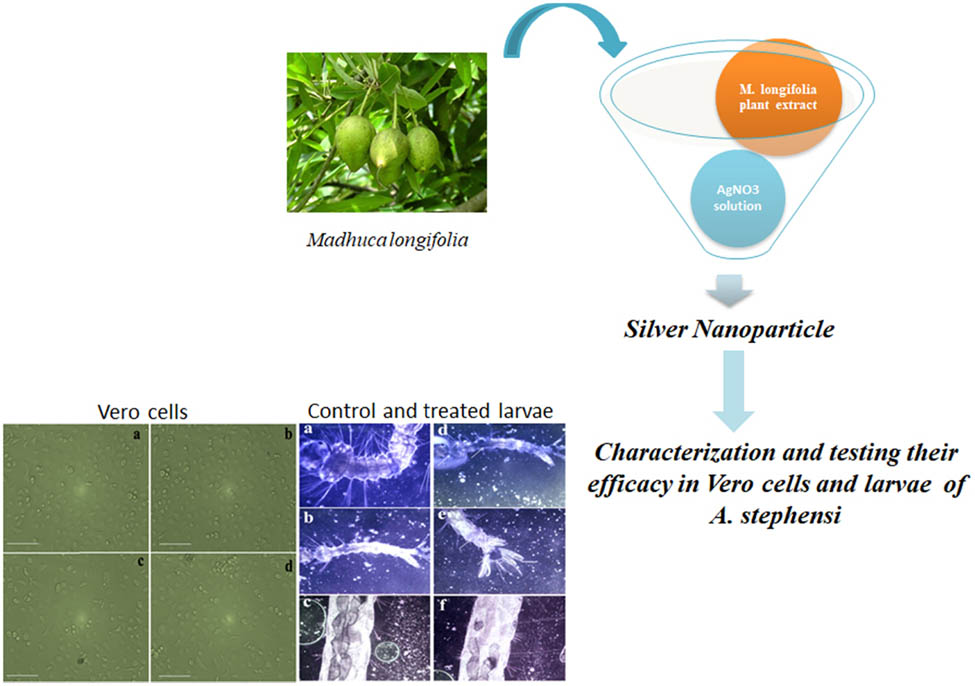
Illustration of AgNP synthesis in the fight against malaria.
1 Introduction
Mosquitoes (Diptera: Culicidae) are the fundamental and first parasitic vectors and they can transmit parasites, pathogens, and a larger number of infections than a few other species of arthropods, which have a devastating effect on many individuals throughout the world. Every year, about 1 billion people are affected, and nearly 1 million people die due to vector-borne insects. Lymphatic filariasis has an impact of over 120 million individuals in 73 nations, including southeast Asia, India, Pacific Islands, and Africa. These diseases demonstrate not only to have an impact over mortality and horribleness, but also have unlimited monetary misfortunes and social obstruction in many nations, including countries in middle east, India, and so forth. India has around 40% of worldwide filariasis presence and is evaluated to cause a yearly annual income loss of 720 crore [1]. The mosquito, Anopheles stephensi (A. stephensi), is the key vector that transmits intestinal sickness among various fields and urban zones of India and other West Asian nations [2,3]. Jungle fever is a mosquito-borne ailment caused by Plasmodium pathogens; besides, it affects directly or indirectly the newborns, youngsters, and causes death in adults. Around 3,000,000 individuals are in danger of intestinal sickness worldwide and 1,000 deaths are caused yearly [4]. Even though World Health Organization has assessed 15 million cases and 20,000 mortalities by the Southeast Asia Regional Office, of all jungle fever cases in Southeast Asia [5], over about 77% of cases were contributed by India. Human intestinal sickness cases are typically because of five Plasmodium sp., specifically P. falciparum, P. malariae, P. vivax, P. ovale, and P. knowlesi [6]. Their control is a significant objective for the improved overall well-being of humans. A few environmental issues, for example, ecological maintainability, unsafe impact on the well being of humans, and other non-target populaces, their non-biodegradable nature, higher pace of organic amplification through biological system, and advancement of obstruction in targeting vectors because of their tenacious gathering on the earth [7,8]. Under these circumstances, eco-accommodating approaches have recently emerged to build control management methods in contrast to mosquito vectors, with unique reference to organic mosquitocidals [9,10]. Therapeutic plants might be an excellent operator for regulation of mosquito menace, since they are rich in optional bioactive compounds, which are dynamic against the predetermined quantity of animal groups and found to be bio-degradable in nature; they are possibly appropriate for use in various control management methods of animals and insects [11]. Recently, scientists have been focusing on plant-related compounds, including their bioactive extracts, which play a pivotal role in targeting mosquitoes. They have mosquitocidal and ovicidal effects and are used as oviposition obstacles, in the development or potentially multiplication inhibitors, and as anti-agents [12,13,14,15,16].
The majority of researchers work to prevent and kill adult female mosquitoes while they are still larval. Paris green and petroleum oil are two substances that successfully kill adult female mosquitoes. While effective, synthetic pyrethroid and many organophosphates are dangerous to unintended aquatic organisms, primarily fish. Using insecticides for malaria sickness is seriously hampered by their harmful and long-lasting effects. The increase in mosquitoes that are resistant to pesticides is a significant obstacle.
In recent years, nanoscience technology research has been extensively found in various field areas including electronics, antibiotics, biomedicine, sensors, catalysts, optical fibers, etc. Nanoparticles have been utilized in many applications, for example, electrochemistry, photochemical, and biomedical. Plants, microorganisms, and organisms have been utilized for the development of nanoparticles. Plant-based green blends of nanoparticles are fast, require minimal effort, are eco-accommodating, and a solitary advance strategy for biosynthesis process [17]; they offer various advantages of financially amiable, ecologically harmonious, and are used for human applications [18]. Until now, metal nanoparticles are generally organized of noble metals like gold (Au), platinum (Pt), lead (Pb), and silver (Ag); among these metals silver (Ag) is one of the best metals for assessing the organic framework [19]. AgNPs are more averse to cause environmental harm and have been distinguished as an expected substitution for manufacturing synthetic bug sprays. Besides, developing numerous plants and shrubs have been planned for productive and fast extracellular production of silver nanoparticles (AgNPs) [20], which show phenomenal mosquitocidal activities in a field environment [21,22].
Madhuca longifolia (normally known as Mahua) belongs to the family Sapotaceae, and is a medium estimated deciduous tree found in many countries, including Nepal, India, and Sri Lanka [23]. Blossoms are light yellow in color and beefy. Further, they are a good source of sugars, nutrients, thiamine, ascorbic acid, calcium, potassium, iron, magnesium, copper, riboflavin, betaines, anthocyanins, and salts of succinic and malic acids [24]. The bark of this plant comprises 17% tannins and utilized for the treatment of stiffness, ulcer, tingles, draining, and light gums [25]. This species is known for their cell reinforcement, antibacterial, antimicrobial, mitigating, anticancer, and antifungal properties [26,27]. The use of large-sized materials in the therapeutic process by herbal medicines has drawbacks, including in vivo instability, poor solubility, low bioavailability, poor absorption in the body, problems with target-specific delivery, and tonic efficacy. Hence, utilizing novel disease-treating systems based on nanotechnology and nanomedicine can be a successful solution to these problems. Effective agents are used in nanotechnology for tissue engineering, drug delivery, biosensors, disease prevention, and remediation. Particles with a nanoscale size exhibit special biological, chemical, mechanical, magnetic, and structural features. Additionally, it clarifies how to use nanomaterials, such as biomimetic materials in living cells and nanosensors for diagnosis and medicine delivery.
Thus, this study mainly focused on the following: (i) characterization of AgNPs biosynthesized from the leaf extract of Madhuca longifolia by utilizing various biophysical approaches including FESEM, UV-vis spectroscopy, EDAX, FTIR, and XRD; (ii) efficacy of the Madhuca longifolia leaf extract and biosynthesized AgNPs against larval and pupal population activity of jungle fever vector A. stephensi. (iii) Furthermore, the counter plasmodial movement of M. longifolia and AgNPs was assessed toward the CQ-safe (CQ-r) and CQ delicate (CQ-s) strains of the jungle fever parasite P. falciparum.
2 Materials and methods
2.1 Madhuca longifolia plant extract
The leaves of M. longifolia were collected from around the Bharathiar University campus and the materials were identified by the taxonomist of the Botany Department, Bharathiar University, and Coimbatore. M. longifolia leaves were desiccated at room temperature and pulverized utilizing an electronic processor. About 500 g of the plant materials was extracted using 1.5 L of methanol (72 h), and the crude plant extract was concentrated using a rotary evaporator and stored at 4°C in the refrigerator. About 1 g of the plant residue was dissolved in 100 mL of acetone, as 1% (w/v) stock solution.
2.2 Synthesis of AgNPs from M. longifolia
About 10 g of the washed leaves was minced into slight pieces in a 300 mL 4088 Erlenmeyer flask containing 100 mL of disinfected two-fold refined water. It was mixed with silver nitrate and boiled for 5 min. Then, it was filtered using Whatman filter paper and stored at −4°C. An earthy-colored yellow formation demonstrated the development of AgNPs. The watery AgNPs were condensed by M. longifolia extract forming stable AgNPs in water [28].
2.3 Characterization of AgNPs
The morphological and physicochemical properties of the synthesized nanomaterials were characterized by different methods. The development of M. longifolia-synthesized AgNPs was observed in the UV-Vis band range of 200–800 nm followed by centrifugation at 15,000 rpm for about 20 min. The obtained pellets were mixed with deionized water. The morphological nature of Ag nanoparticles was confirmed under a scanning electron microscope. Furthermore, the size and functional groups of the nanoparticles were observed using FTIR spectroscopy and, finally, the phase purity of nanoparticles was determined by XRD and EDAX [28].
2.4 Larval morphological changes
A. stephensi eggs were collected from the neighborhood water body (Tabuk region, Saudi Arabia). Eggs were moved to research facility conditions (28 ± 3°C, 76–88% RH, 13:11 photoperiod) and set in 20 cm × 12 cm × 5 cm plastic compartments containing 500 mL of distilled water. Hatchlings were taken care with a blend of canine scones and hydrolyzed yeast. Hatchlings were gathered, moved to a glass dish loaded with 500 mL of DD water, and subjected to ensuing tests. The transferred hatchlings were treated with different convergences of the biosynthesized material for 24 h incubation, after brooding over the rewarded and untreated hatchlings were broken down under minute conditions.
2.5 Larval/pupal toxicity assessment
Following the methods reported by Kovendan et al. [29] A. stephensi larvae (I-IV instar) or pupae (25 nos) were taken from the conical flask containing 250 mL of distilled water, 20, 40, 60, 80, and 100 ppm (individually) concentrations of the M. longifolia leaf extract, and 2, 4, 6, 8, and 10 ppm of synthesized AgNPs (individually). The control was separately maintained in this experiment against A. stephensi [29]. All treatments were repeated five times against larva and pupa. Mortality rate (%) was calculated as follows:
2.6 Cytotoxic effect of AgNPs on Vero cells
Vero cells were obtained from NCCS (National Centre for Cell Sciences) located in Pune, India. Cells were maintained in a Dulbecco’s modified Eagle’s medium (DMEM) supplemented with balanced salt solution and 2 mM l-glutamine, which contained 1.5 g·L−1 Na2CO3, 1.5 g·L−1 glucose, 2 mM l-glutamine, 0.1 mM non-essential amino acids, 10 mM (4-(2-hydroxyethyl)-1-piperazineethane sulfonic acid) (HEPES), 1 mM sodium pyruvate, and 10% fetal bovine serum. Also, 100 IU·of 100 µg−1 streptomycin and 1 mL·L−1 penicillin were used. Further, the cells were retained at 5% CO2 in a humidified CO2 atmosphere at 37°C. The cells were treated with varied concentrations of AgNPs for about 24 h.
2.7 Assessment of cytotoxicity
Cell cytotoxicity assay (MTT, Hi-Media) was done to measure the inhibitory concentration (IC50) values. Vero cells were developed in 96-well plate (1 × 104 cells·well−1) to obtain 80% confluency for 48 h. The medium was then substituted with AgNPs comprising fresh medium at different concentrations (10, 20, or 50 μM); similarly, they were treated with M. longifolia extract followed by incubation for 48 h. Consequently, the culture medium was observed, and 100 µL of MTT was then added to each of the well. Then, the temperature was increased to 37°C for 4 h, accompanied by the supernatant elimination. Further, 50 µL of DMSO was added to each well and then reared approximately for 10 min to formazan crystal solubilization. The optical density (OD) of the cells was read using an Elisa plate reader (Thermo Multiskan EX, USA) fixed at 490 nm. Further, the cytotoxicity of the AgNPs was calculated using the following formula:
2.8 Morphological investigation
Vero cells were allowed to multiply on coverslips (1,105 cells) and then incubated with AgNPs at various concentrations for 6–24 h before being fixed with ethanol/acetic acid (3:1; v/v) solution. For morphological observation, the cover slips were loosely placed to glass slides. Three monolayers of each experiment were photographed. Using a light microscope (Nikon, Japan) with a 20× magnification, the morphological changes of the treated cells were examined.
2.9 Parasite culture
Human erythrocytes from RP-mature C’s layer of cells generated parasites: The RPMI culture was prepared by adding 25 mM HEPES, l-glutamine, and 16.2 g of powdered RPMI 1640 without sodium bicarbonate. To create an initial parasitemia between 0.1% and 1.0%, freshly cleansed RBC was added to the parasites. In order to culture the expansion of new erythrocytes for every 4–5 days, the incubation environment was maintained with 1.5% O2, 5% CO2, and 95% nitrogen atmosphere [30]. The media were changed every 24 h.
2.10 In vitro antiplasmodial investigation
The control stock solution of chloroquine was prepared in DD water. The M. longifolia extract AgNP suspension was prepared in dimethyl sulfoxide. In all groups, with the exception of CQ, the last arrangement contained 0.4% DMSO. The antiplasmodial activity of the concentrate of the M. longifolia extract AgNP test was determined by adding it to a 96-well plate as done by Rieckmann [31], with the modification shown by Carvalho et al. [32]. A solution of infected RBC containing most trophozoites was inoculated to the well to make a final volume of 100 mL. The positive control was CQ, and uninfected and contaminated RBC was incorporated with a negative standard. The well plates were kept at 37°C, followed by 24 h incubation with and without freshly containing AgNPs. After brooding for 24 h, Giemsa-stained blood films were set up in every well of the plates, and the level of restraint of parasite development was determined using a visualizing instrument by examining the number of sporozoites with at least minimum three independent test experiments with that of control wells.
2.11 Statistical analysis
SPSS programming version 16.0 variant was used for all experiments. Data from mosquitocidal tests were analyzed by probit investigation, containing lethal concentrations 50 and 90 [33]. In anti-plasmodial examination, values were determined as rate development hindrance; the focus causing half restraint of parasite development (IC50) was determined from the medication fixation reaction curves.
3 Results and discussion
3.1 Characterization of M. longifolia-synthesized AgNPs
Humanity benefits from the development of affordable, dependable, and environmentally friendly approaches to increase the synthesis and effectiveness of nanoparticles [34]. Because of the impact of surface plasmon resonance, silver nitrate was reduced when plant filtrates were added, which was followed by a slight increase in the shading from clear to yellowish earthy color (SPR). UV-Vis spectroscopy, one of the most often used techniques, was used to observe the auxiliary portrayal of AgNPs. The light earthy shading was produced by increasing the hatching time. The pale earthy-colored shading of silver colloids inclusion range showed a clear peak at 425 nm (Figure 1).
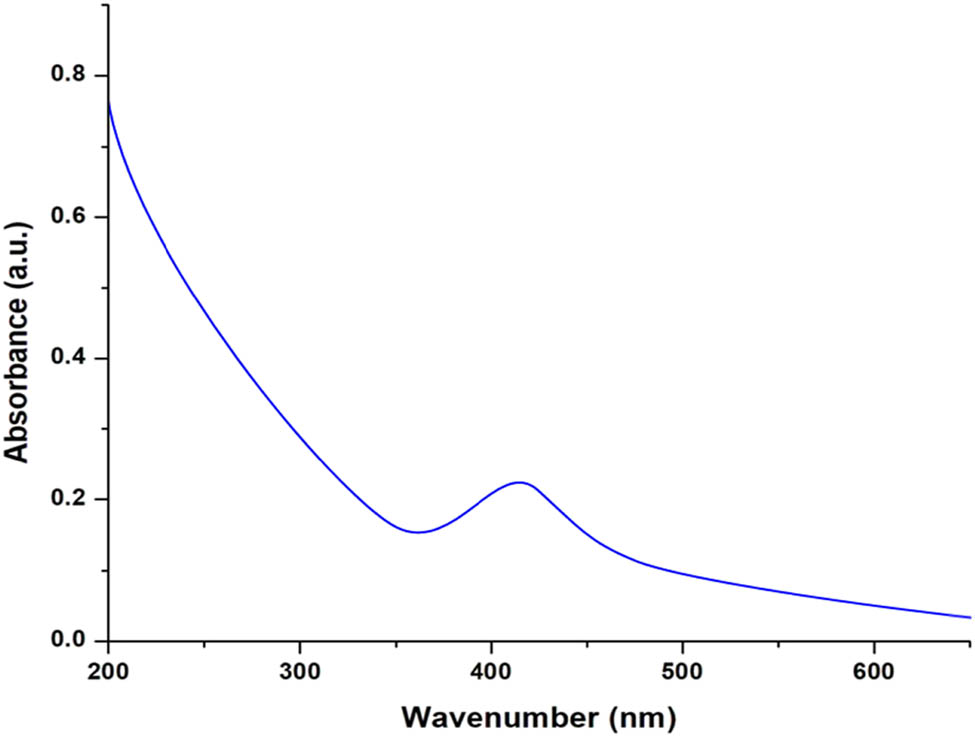
UV-Vis spectrum of M. longifolia-synthesized AgNPs.
In concurrence with our outcomes, a peak with most extreme retention at 410 nm described the biosynthesis of Aloe vera-synthesized AgNPs [22]. Essentially, the Delphinium denudatum AgNPs synthesized showed a peak with most extreme retention at 416 nm. Additionally, the position and condition of AgNP plasmon ingestion are greatly influenced by the molecule size, surface-adsorbed species, and the dielectric medium [35].
Four extreme peaks in the two-value range, spanning values of 25–60, are visible in the XRD spectrum. In the current experiment, the AgNPs were framed at two estimates of 38.32°, 52.45°, and 66.65° in comparison to planes for silver, individually (Figure 2). The XRD image clearly demonstrates that AgNPs were crystalline in character and were formed by the reduction of AgNO3 particles by M. longifolia. For AgNPs made from Acalypha indica, similar results have been explained [36].
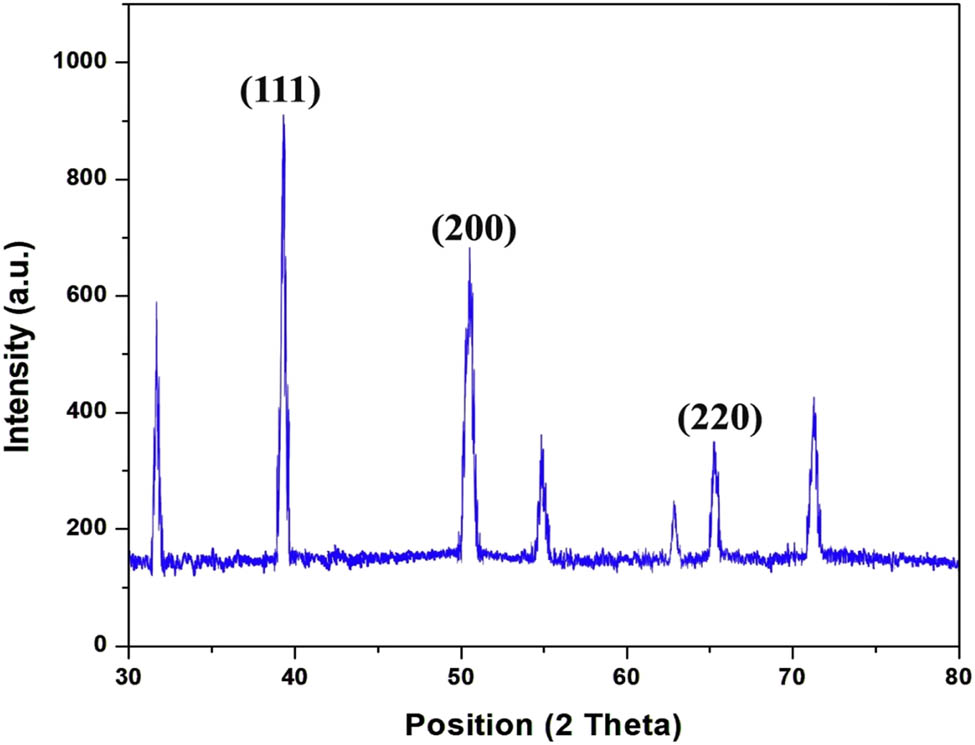
XRD pattern of M. longifolia-synthesized AgNPs.
FTIR analysis was done to distinguish conceivable biomolecules on the M. longifolia leaf extract that might be liable for biosynthesis and adjustment of AgNPs. An FTIR spectrum for the synthesis of AgNPs is shown in Figure 3. The significant peaks in the FTIR range of AgNPs have been seen at 648, 1,216, 1,819, and 3,984 cm−1. Additionally, for the FTIR range of Delphinium denudatum root extricate, the peaks were seen at 3,354, 2,952, 2,063, 1,651, 1,419, 1,383, 1,354, 1,171, 1,093, 780, 672, and 605 cm−1. The FTIR had featured the nearness of various utilitarian gatherings, including alkane, alkene, methylene, amine, and carboxylic groups, which are known to be present in the biosynthesized AgNPs [37].
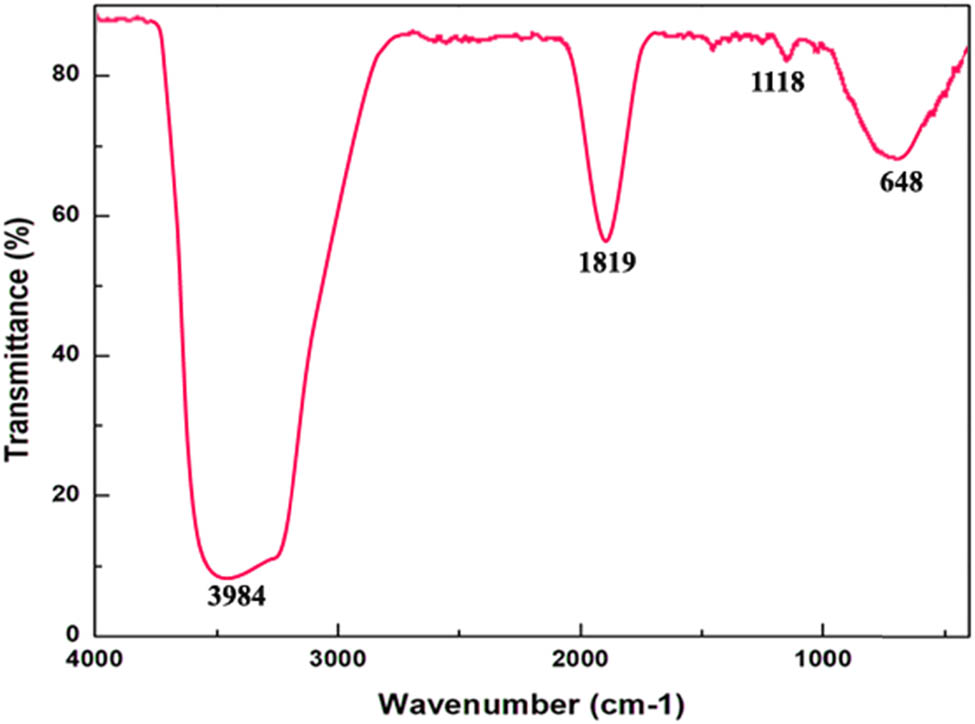
FTIR spectrum of M. longifolia-synthesized AgNPs.
SEM micrographs demonstrated that M. longifolia-integrated AgNPs were primarily spherical in shape, ranging from 20 to 40 nm (Figure 4). Ulva lactuca-synthesized AgNPs were found to be in appropriation of sizes, mostly ranging from 20 to 35 nm [38]. The EDX graph uncovered a solid sign in the Ag area, affirming the nearness of natural Ag, demonstrating a sharp peak at 3 keV, for the synthesized AgNPs (Figure 5). Essentially, metallic Ag nanocrystals demonstrated an average optical retention peak roughly at 3 keV because of SPR [39,40]. EDX likewise indicated the nearness of oxygen, indicating that AgNPs were topped by the natural parts present in the seaweeds, as additionally featured by the FTIR investigation [41,42].
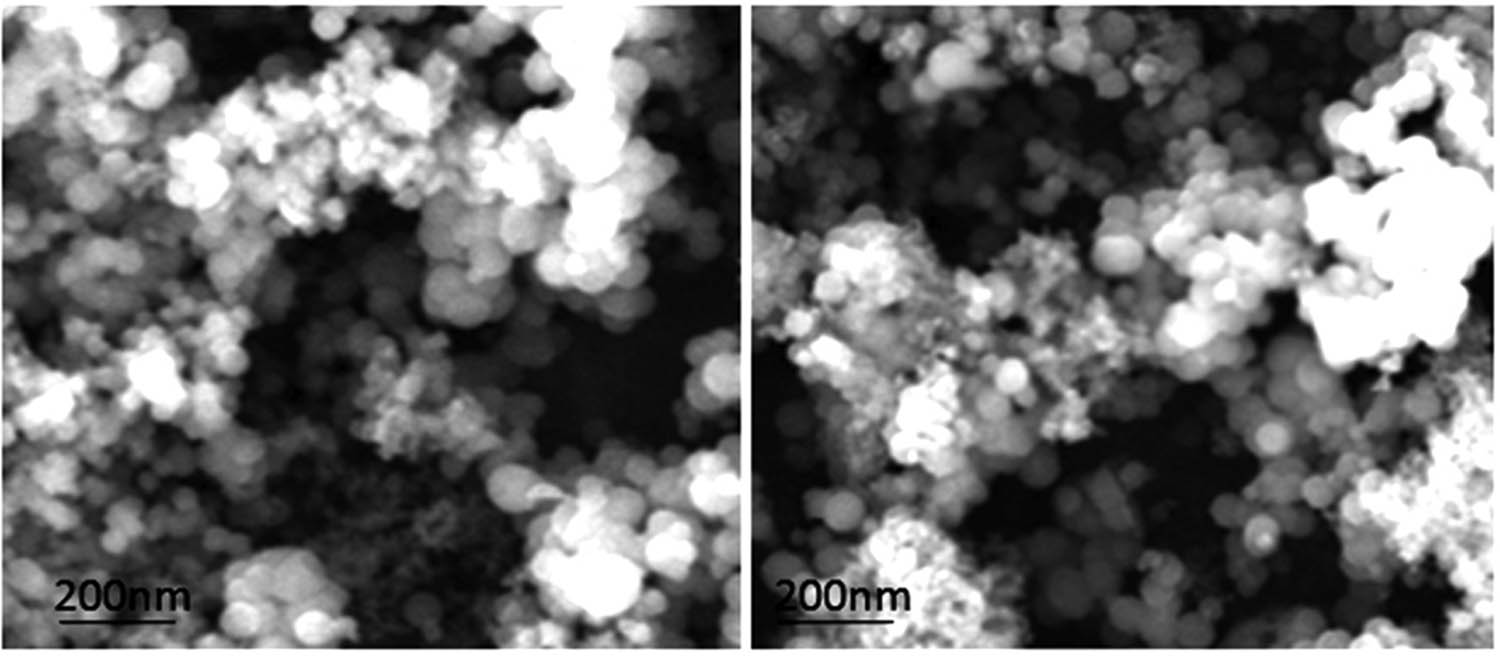
SEM micrograph showing the morphological characteristics of M. longifolia-synthesized AgNPs.
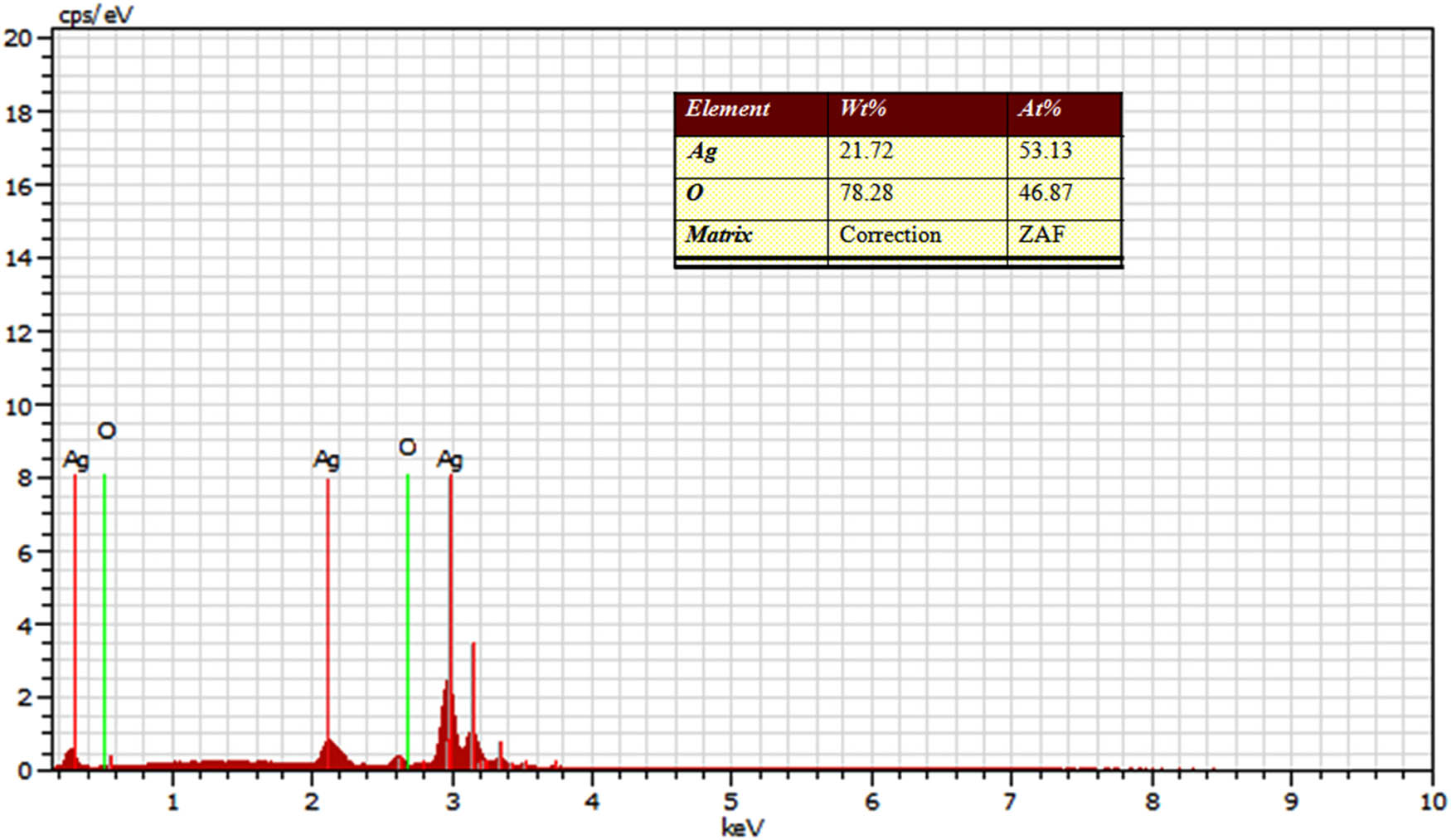
EDX spectrum of M. longifolia-synthesized AgNPs.
3.2 Mosquitocidal action
In the laboratory analysis, the M. longifolia filtrate was found to be poisonous against hatchlings and pupae of A. stephensi, regardless of whether tried at low dosages. LC50 values were found to be 31.577 (I), 43.657 (II), 63.084 (III), 74.895 (IV), and 119.258 ppm (pupal population stages) (Table 1) at different instars, respectively. Likewise, a subsidiary impact was found as recently published by Benelli et al. [8]; Murugan et al. [43] had shown for other plant-borne mosquitocidals. Further, the research center analysis had shown M. longifolia interceded AgNPs to have profoundly expanded larval and pupal mortality against A. stephensi. The LC50 values were found to be 1.302 (I), 2.035 (II), 2.181 (III), 3.876 (IV), and 6.102 ppm (pupal population stages) (shown in Table 2). In contrast to A. stephensi, Arokiyaraj et al. [44] considered the larvicidal activity of AgNPs included by botanical concentrate of C. indicum. It should be noted that additional AgNPs produced by Aloe vera were extremely viable at lower concentrations than those used in the current study [22]. Recently, Mondal et al. [45] reported that Colocasia esculenta stem-synthesized AgNP filtrate concentrate was biotoxic to Culex quinquefasciatus hatchlings, with greater mortality at extremely low concentrations.
Acute toxicity of M. longifolia aqueous extracts against larvae and pupae of the malaria vector A. stephensi
| Target | LC50 (LC90) (mg·L−1) | 95% confidence limit | Regression equation | x 2 | |
|---|---|---|---|---|---|
| LC50 (LC90) (mg·L−1) | |||||
| LCL | UCL | ||||
| I instar | 41.460 (121.404) | 31.577 (106.579) | 48.993 (145.744) | y = −0.665 + 0.016x | 0.053n.s |
| II instar | 53.005 (145.398) | 43.657 (124.530) | 61.181 (182.580) | y = −0.735 + 0.014x | 0.205n.s |
| III instar | 72.285 (176.627) | 63.084 (146.882) | 84.228 (234.545) | y = −0.888 + 0.012x | 0.054n.s |
| IV instar | 86.002 (199.629) | 74.895 (162.083) | 104.335 (278.465) | y = −0.970 + 0.011x | 0.316n.s |
| Pupae | 151.951 (304.488) | 119.258 (220.588) | 252.400 (573.433) | y = −1.277 + 0.008x | 0.056n.s |
Control = no mortality; LC50 = lethal concentration killing 50% of the insects; LC90 = lethal concentration killing 90% of the insects; χ 2 = chi-square; n.s. = not significant (α = 0.05).
Acute toxicity of M. longifolia-synthesized AgNPs against larvae and pupae of the malaria vector A. stephensi
| Target | LC50 (LC90) (mg·L−1) | 95% confidence Limit | Regression equation | x 2 | |
|---|---|---|---|---|---|
| LC 50 (LC90) (mg·L−1) | |||||
| LCL | UCL | ||||
| I instar | 1.302 (6.660) | 0.025 (5.975) | 2.146 (7.619) | y = −0.311 + 0.239x | 5.246n.s |
| II instar | 2.035 (10.058) | 0.442 (8.829) | 3.046 (12.092) | y = −0.325 + 0.160x | 5.053n.s |
| III instar | 2.181 (12.017) | 0.185 (10.250) | 3.348 (15.328) | y = −0.284 + 0.130x | 2.150n.s |
| IV instar | 3.876 (16.435) | 1.991 (13.306) | 5.028 (23.444) | y = −0.396 + 0.102x | 0.007* |
| Pupae | 6.102 (21.077) | 4.664 (16.194) | 7.592 (34.142) | y = −0.522 + 0.086x | 0.072n.s |
Control = no mortality; LC50 = lethal concentration killing 50% of the insects; LC90 = lethal concentration killing 90% of the insects; χ 2 = chi-square; n.s. = not significant (α = 0.05).
3.3 Cytotoxic assay
The MTT test was used to determine how biosynthesized AgNPs affected the mortality of Vero cells. The in vitro cytotoxic activity of AgNPs (concentrations: 10–100 g·mL−1) against the selected cells is shown in Figure 6. The test findings demonstrated that the particles did not completely prevent cell division. Instead, the fact that the majority of the cells (60%) were in a healthy state suggested that the substance was ideal for use in the selected cells. The results clearly showed that the IC50 cell reasonability is what caused the cells to be so similar to one another. According to a previous research, AgNP particles incubated with Vero cells for 72 h showed reduced or no toxicity to mammalian cells [46].
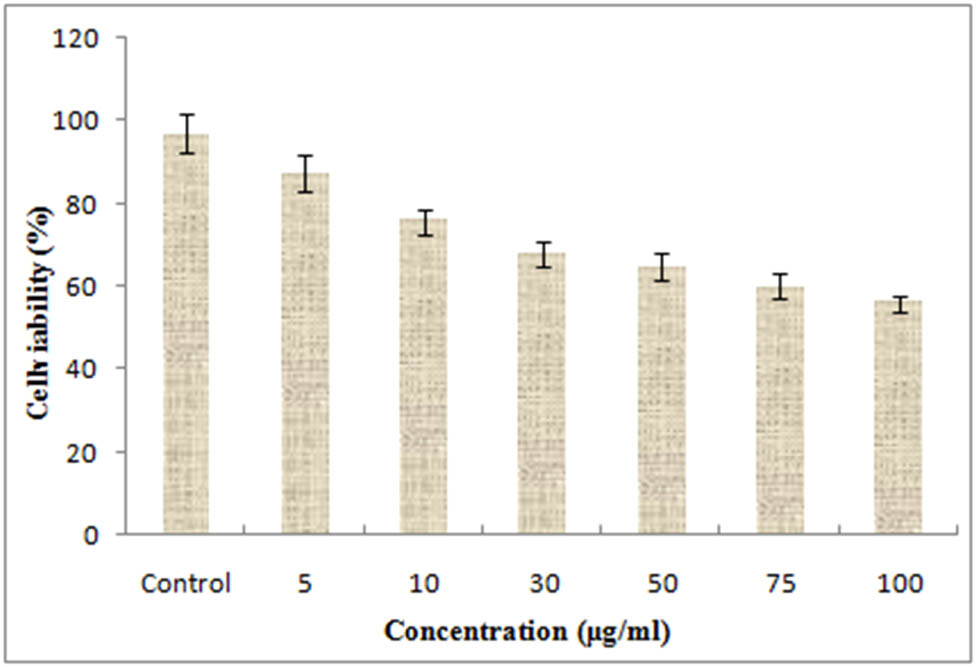
Cytotoxic effect of the synthesized AgNPs on Vero cells.
3.4 Cell morphology investigation
The morphological changes of chosen cells in the presence and absence of AgNPs at different concentrations are shown in Figure 7. It can be seen from Figure 7 that the control cells did not show any exceptional changes on their morphology. Nevertheless, AgNPs were not shown to have any unfavorable impact to the Vero cells. The cytological examinations evidenced that the synthesized AgNPs are profoundly biocompatible to the framework and explicitly harmful to the parasites.
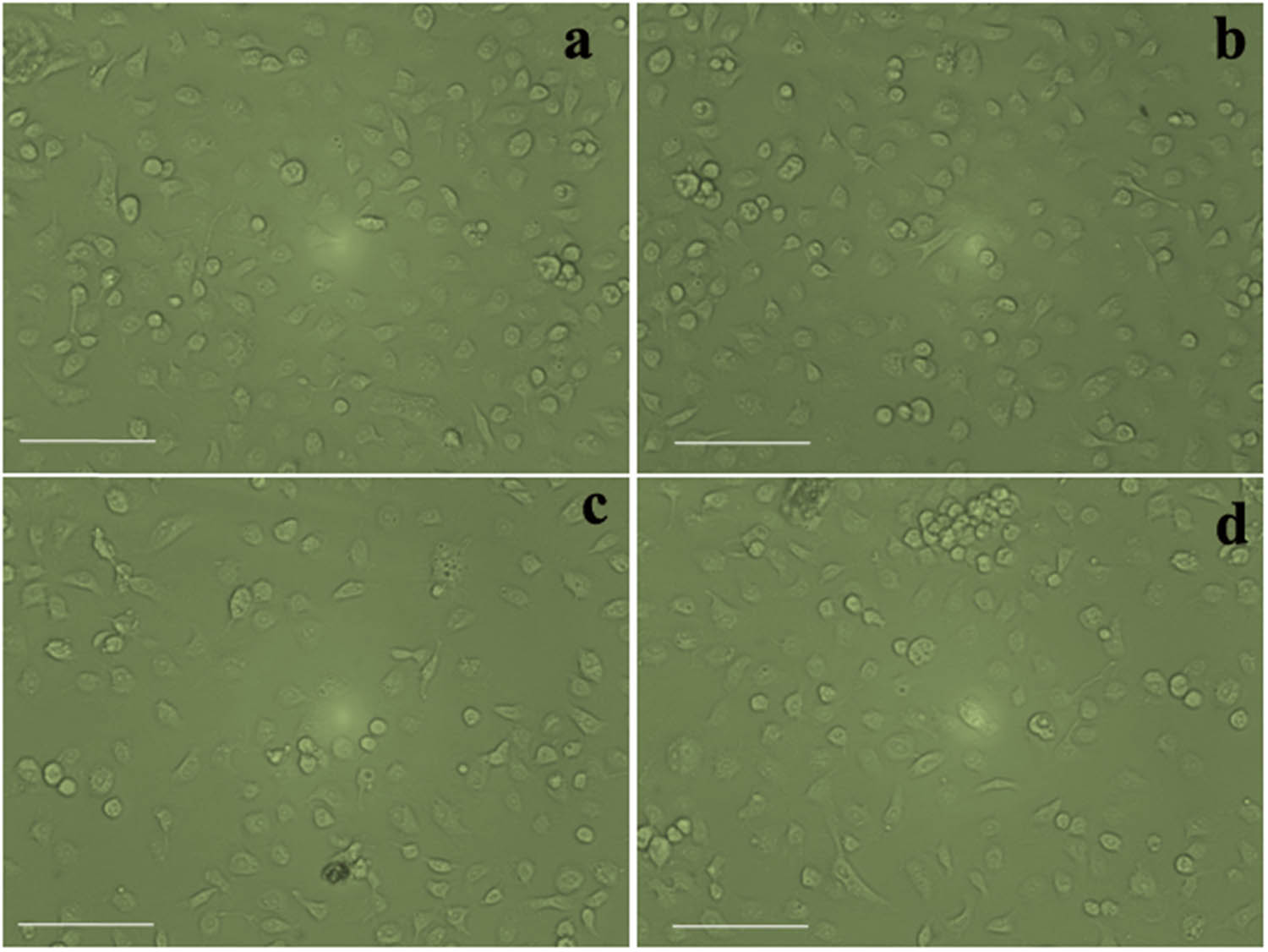
Morphological observation of synthesized AgNP-treated Vero cells: (a) control, (b) 25 μg·mL−1, (c) 50 μg·mL−1, and (d) 100 μg·mL−1.
3.5 Larval deformity
As shown in Figure 8, introduction of AgNPs caused neglect of improvement on the ordinary morphology, the regularly contortions including shrinkage mid-region and tracheal gills stomach extremities in mosquito hatchlings. The locomotory movement of hatchlings at 6 dpf time point (after the AgNP presentation period) was broken down irrespective of if the blended particles introduction could have a relentless consequence for larval conduct. We found that the rewarded hatchlings decreased locomotory conduct and butt-centric papillae gnawing conduct. Farida et al. [47] had revealed the harmfulness of the metabolites of B. bassiana on the fourth instar hatchlings of Cx. pipiens and had observed numerous histological alterations and contortion in the rewarded larval tissues and body, particularly in fat cells and fingernail skin. Other findings had detailed that the midgut of tried mosquitoes’ hatchlings had increased in the gut lumen and decreased the intercellular substance and deterioration of cores, when P. daleae mycelium were removed [48].
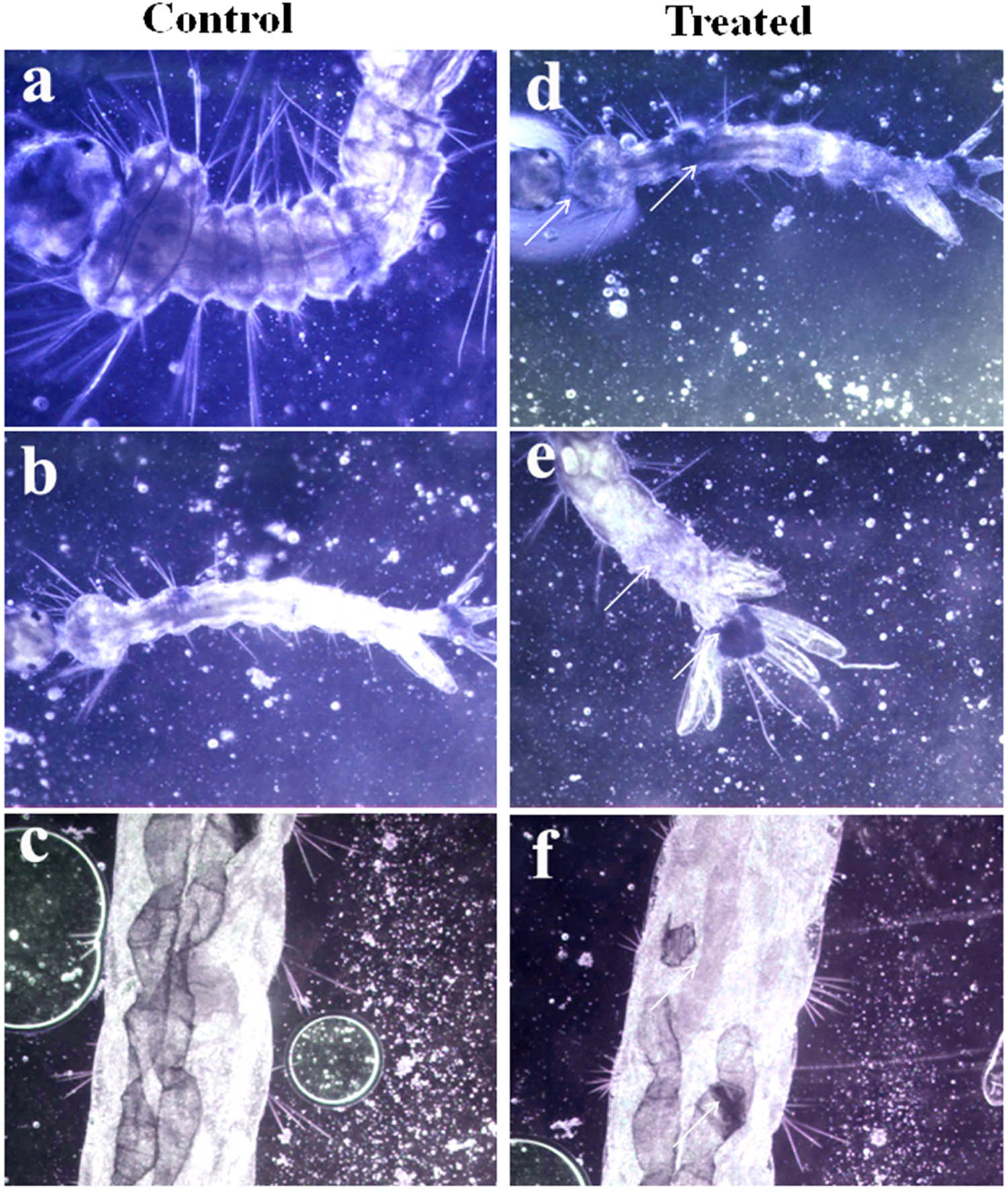
Microscopic analysis of the synthesized AgNPs on mosquito larvae: (a–c) untreated mosquito larvae; (d–f) AgNP-treated mosquito larvae.
3.6 Antiplasmodial tests
Figures 9 and 10 show that the efficacy of AgNPs orchestrated with M. longifolia at various focuses on the restraint pace of the malarial parasites, which was seen subsequent to the plant extract treatment. Extreme inhibition ranges were seen subsequent to the treatment with synthesized AgNPs. The lowest inhibition range of parasitemia (44.5%) was seen in parasites at 50 ppm concentration of M. longifolia-synthesized AgNPs. Further, the parasitemia inhibition ranges were extremely high, about 44.5%, 66.2%, and 80.4% for 50, 75, and 100 ppm, respectively, for M. longifolia-synthesized AgNPs. Similarly, Mimosa pudica leaf extracts and AgNPs were shown to have a good antiparasitic activity [49]. Also, Murugan et al. [16] found that the antiplasmodial activities of O. basilicum and S. occidentalis were not in favor of CQ (s and r) strains of P. falciparum. Further, Murugan et al. [38] revealed that the antiplasmodial action of U. lactuca-seaweed-synthesized AgNPs were not in favor of CQ (s and r) strains of P. falciparum, while in U. lactuca-synthesized AgNPs, the IC50 values were 76.33 (CQ-s) and 79.13 μg·mL−1 (CQ-r). This information on the antiplasmodial activity of M. longifolia-synthesized AgNPs implies that IC50 values would be useful in understanding their antimalarial properties.
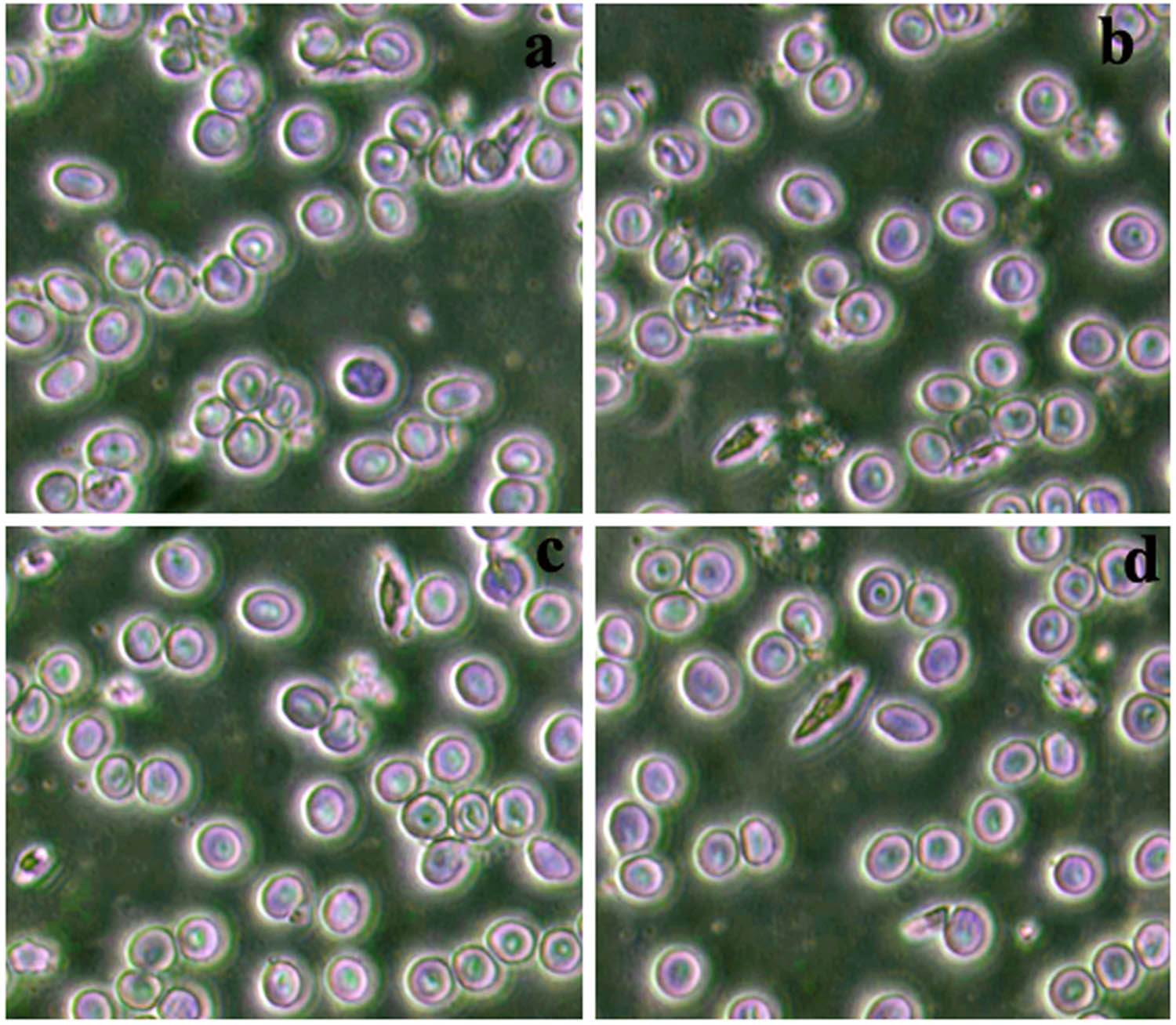
Antiplasmodial activity of the synthesized AgNPs against P. falciparum: (a) control, (b) 50 ppm, (c) 75 ppm, and (d) 100 ppm.
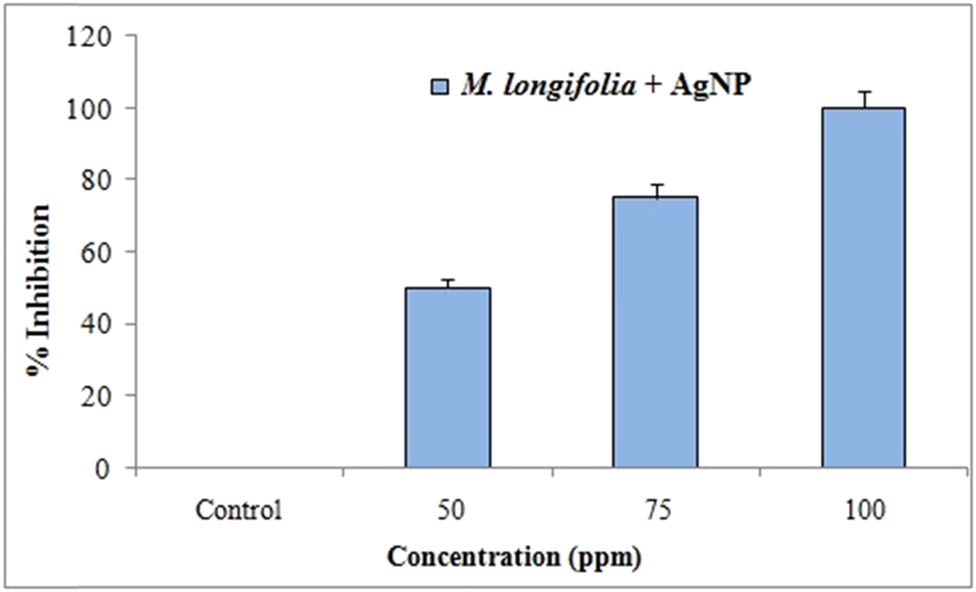
In vitro antiplasmodial activity of AgNPs synthesized using M. longifolia against the malaria parasite P. falciparum.
4 Conclusion
The goal of this study is to study eco-friendly green-blended AgNPs against the A. stephensi malaria vector. The quick and inexpensive synthesis of AgNPs was confirmed by IR, SEM, XRD, UV-Vis spectroscopy. This study demonstrated that M. longifolia-intervened AgNPs can be used at small dosages to effectively reduce populations of the jungle fever vector. Up to 100 g·mL−1, the cytotoxic effect of the biosynthesized nanomaterial on African green monkey kidney cells was considered to be of negligible toxicity. The combined effects of the inserted AgNPs led to A. stephensi larval deformation during the instar phase, which prompted larval passage. In conclusion, M. longifolia-intervened AgNPs has the potential to impede the growth of the P. falciparum malaria parasite. This study demonstrated that the biosynthesized AgNPs can be employed to build safer and more recent specialists for the control of intestinal illness in the near future.
Acknowledgements
The authors thank the Department of Zoology, Bharathiar University, for providing the laboratory facilities.
-
Funding information: The authors state no funding involved.
-
Author contributions: Chellasamy Panneerselvam: conducted the experiments and data compilation; Abdullah F. Shater, Fayez M. Saleh, Zuhair M. Mohammedsaleh: wrote the draft and discussed the results; Hattan Gattan, Bassam M. Al-Ahmadi, Nizar H. Saeedi: contributed to formal analysis and data curation; Mohammed M. Jalal, Chellasamy Panneerselvam: reviewed and edited the manuscript. All authors have read and agreed to the published version of the manuscript.
-
Conflict of interest: The authors state no conflict of interest.
-
Data availability statement: The authors confirm that the data supporting the findings of this study are available in the article.
References
[1] Hotez PJ, Remme JH, Buss P, George G, Morel C, Breman JG. Combating tropical infectious diseases: report of the disease control priorities in developing Countries project. Clin Infect Dis. 2004;38(6):871–8.10.1086/382077Search in Google Scholar PubMed
[2] Burfield T, Reekie SL. Mosquitoes, malaria and essential oils. Inter J Aroma. 2005;15(1):30–41.10.1016/j.ijat.2004.09.013Search in Google Scholar
[3] Mittal PK, Adak T, Subbarao SK. Inheritance of resistance to Bacillus sphaericus toxins in a laboratory selected strain of Anopheles stephensi (Diptera Culicidae) and its response to Bacillus thuringiensis var. israelensis. Curr Sci. 2005;89(3):442–3.Search in Google Scholar
[4] Guerra CA, Snow RW, Hay SI. A global assessment of closed forests, deforestation and malaria risk. Ann Trop Med Parasitol. 2006;100(3):189.10.1179/136485906X91512Search in Google Scholar PubMed PubMed Central
[5] Kumar A, Shukla R, Singh P, Prasad CS, Dubey NK. Assessment of Thymus vulgaris L. essential oil as a safe botanical preservative against post-harvest fungal infestation of food commodities. Innov Food Sci Emerg Tech. 2008;9(4):575–80.10.1016/j.ifset.2007.12.005Search in Google Scholar
[6] Duval L, Nerrienet E, Rousset D, Sadeuh Mba SA, Houze S, Fourment M, et al. Chimpanzee malaria parasites related to Plasmodium ovale in Africa. PLoS One. 2009;4(5):5520.10.1371/journal.pone.0005520Search in Google Scholar PubMed PubMed Central
[7] Mulla MS, Thavara U, Tawatsin A, Chomposri J, Su T. Emergence of resistance and resistance management in field populations of tropical Culex quinquefasciatus to the microbial control agent Bacillus sphaericus. J Amer Mos Cont Assoc. 2003;19(1):39–46.Search in Google Scholar
[8] Benelli G, Bedini S, Cosci F, Toniolo C, Conti B, Nicoletti M. Larvicidal and ovideterrent properties of neem oil and fractions against the filariasis vector Aedes albopictus (Diptera: Culicidae): a bioactivity survey across production sites. Parasitol Res. 2015a;114(1):227–36.10.1007/s00436-014-4183-3Search in Google Scholar PubMed
[9] Azizullah A, Rehman ZU, Ali I, Murad W, Muhammad N, Ullah W, et al. Chlorophyll derivatives can be an efficient weapon in the fight against dengue. Parasitol Res. 2014;113(12):4321–6.10.1007/s00436-014-4175-3Search in Google Scholar PubMed
[10] Benelli G, Bedini S, Flamini G, Cosci F, Cioni PL, Amira S, et al. Mediterranean essential oils as effective weapons against the West Nile vector Culex pipiens and the Echinostoma intermediate host Physella acuta: what happens around? An acute toxicity survey on non-target mayflies. Parasitol Res. 2015b;114(3):1011–21.10.1007/s00436-014-4267-0Search in Google Scholar PubMed
[11] Alkofahi A, Rupprecht JK, Anderson JE, Mclaughlin JL, Mikolajczak KL, Scott BA. Search for new pesticides from higher plants. Insect Plan Orig. 1989;387:25–43.10.1021/bk-1989-0387.ch003Search in Google Scholar
[12] Semmler M, Abdel-Ghaffar F, Al-Rasheid K, Mehlhorn H. Nature helps: from research to products against blood-sucking arthropods. Parasitol Res. 2009;105(6):1483–7.10.1007/s00436-009-1634-3Search in Google Scholar PubMed
[13] Panneerselvam C, Murugan K, Kovendan K, Kumar PM, Subramaniam J. Mosquito larvicidal and pupicidal activity of Euphorbia hirta Linn. (Family: Euphorbiaceae) and Bacillus sphaericus against Anopheles stephensi Liston. (Diptera: Culicidae). Asia Pac J Trop Med. 2013;6(2):102–9.10.1016/S1995-7645(13)60003-6Search in Google Scholar PubMed
[14] Murugan K, Benelli G, Ayyappan S, Dinesh D, Panneerselvam C, Nicoletti M, et al. Toxicity of seaweed-synthesized silver nanoparticles against the filariasis vector Culex quinquefasciatus and its impact on predation efficiency of the cyclopoid crustacean Mesocyclops longisetus. Parasitol Res. 2015a;114(6):2243–53.10.1007/s00436-015-4417-zSearch in Google Scholar PubMed
[15] Murugan K, Benelli G, Panneerselvam C, Subramaniam J, Jeyalalitha T, Dinesh D, et al. Cymbopogon citratus-synthesized gold nanoparticles boost the predation efficiency of copepod Mesocyclops aspericornis against malaria and dengue mosquitoes. Exp Parasitol. 2015b;153:129–38.10.1016/j.exppara.2015.03.017Search in Google Scholar PubMed
[16] Murugan K, Aarthi N, Kovendan K, Panneerselvam C, Chandramohan B, Kumar PM, et al. Mosquitocidal and antiplasmodial activity of Senna occidentalis (Cassiae) and Ocimum basilicum (Lamiaceae) from Maruthamalai hills against Anopheles stephensi and Plasmodium falciparum. Parasitol Res. 2015c;114(10):3657–64.10.1007/s00436-015-4593-xSearch in Google Scholar PubMed
[17] Huang J, Li Q, Sun D, Lu Y, Su Y, Yang X, et al. Biosynthesis of silver and gold nanoparticles by novel sundried Cinnamomum camphora leaf. Nanotechnol. 2007;18(10):105104.10.1088/0957-4484/18/10/105104Search in Google Scholar
[18] Kumar V, Yadav SK. Plant‐mediated synthesis of silver and gold nanoparticles and their applications. J Chem Technol Biotechnol Int Res Process Env Clean Tech. 2009;84(2):151–7.10.1002/jctb.2023Search in Google Scholar
[19] Singh J, Dutta T, Kim KH, Rawat M, Samddar P, Kumar P. ‘Green’synthesis of metals and their oxide nanoparticles: applications for environmental remediation. J Nanobiotech. 2018;16(1):1–24.10.1186/s12951-018-0408-4Search in Google Scholar PubMed PubMed Central
[20] Benelli G. Research in mosquito control: current challenges for a brighter future. Parasitol Res. 2015;114(8):2801–5.10.1007/s00436-015-4586-9Search in Google Scholar PubMed
[21] Amerasan D, Nataraj T, Murugan K, Panneerselvam C, Madhiyazhagan P, Nicoletti M, et al. Myco-synthesis of silver nanoparticles using Metarhizium anisopliae against the rural malaria vector Anopheles culicifacies Giles (Diptera: Culicidae). J Pest Sci. 2016;89(1):249–56.10.1007/s10340-015-0675-xSearch in Google Scholar
[22] Dinesh D, Murugan K, Madhiyazhagan P, Panneerselvam C, Mahesh Kumar P, Nicoletti M, et al. Mosquitocidal and antibacterial activity of green-synthesized silver nanoparticles from Aloe vera extracts: towards an effective tool against the malaria vector Anopheles stephensi? Parasitol Res. 2015;114(4):1519–29.10.1007/s00436-015-4336-zSearch in Google Scholar PubMed
[23] Khare P, Kishore K, Sharma DK. Medicinal uses, Phytochemistry and Pharmacological profile of Madhuca longifolia. Asia J Pharm Pharmacol. 2018;4(5):570–81.10.31024/ajpp.2018.4.5.5Search in Google Scholar
[24] Yoshikawa K, Tanaka M, Arihara S, Pal BC, Roy SK, Matsumura E, et al. New Oleanene Triterpenoid Saponins from Madhuca longifolia. J Nat Prod. 2000;63(12):1679–81.10.1021/np000351rSearch in Google Scholar PubMed
[25] Bhatnagar SC, Awasthi YC, Mitra CR. Steroidal and other constituents of Madhuca latifolia leaves. Phyto chem. 1972;11(1):465–7.10.1016/S0031-9422(00)90058-XSearch in Google Scholar
[26] Nimbekar T, Bais Y, Katolkar P, Wanjari B, Chaudhari S. Antibacterial activity of the dried inner bark of Madhuca indica JF GMEL. Bull Env Pharm Life Sci. 2012;1(2):26–9.Search in Google Scholar
[27] Bhaumik A, Kumar MU, Khan KA, Srinivas CH. The bioactive compounds obtained from the fruit-seeds of Madhuca longifolia (L) act as potential anticancer agents. Scholar J Appl Med Sci. 2014;2(4A):1235–8.Search in Google Scholar
[28] Rajaganesh R, Murugan K, Panneerselvam C, Jayashanthini S, Roni M, Suresh U, et al. Fern-synthesized silver nanocrystals: towards a new class of mosquito oviposition deterrents? Res Veter Sci. 2016;109:40–51.10.1016/j.rvsc.2016.09.012Search in Google Scholar PubMed
[29] Kovendan K, Murugan K, Vincent S, Barnard DR. Studies on larvicidal and pupicidal activity of Leucas aspera Willd. (Lamiaceae) and bacterial insecticide, Bacillus sphaericus, against malarial vector, Anopheles stephensi Liston.(Diptera: Culicidae). Parasitol Res. 2012;110(1):195–203.10.1007/s00436-011-2469-2Search in Google Scholar PubMed
[30] Trager W, Jenson JB. Cultivation of malarial parasites. Nat. 1978;273(5664):621–2.10.1038/273621a0Search in Google Scholar PubMed
[31] Rieckmann K. Visual in-vitro test for determining the drug sensitivity of Plasmodium falciparum. Lancet. 1982;319(8285):1333–5.10.1016/S0140-6736(82)92403-5Search in Google Scholar
[32] Carvalho LH, Brandao MG, Santos-Filho D, Lopes JL, Krettli AU. Antimalarial activity of crude extracts from Brazilian plants studied in vivo in Plasmodium berghei-infected mice and in vitro against Plasmodium falciparum in culture. Braz J Med Biol Res. 1991;24(11):1113–23.Search in Google Scholar
[33] Finney DJ. Probit analysis. Cambridge, UK: Cambridge University Press; 1971. p. 333.Search in Google Scholar
[34] Bhattacharya D, Gupta RK. Nanotechnology and potential of microorganisms. Crit Rev Biotech. 2005;25(4):199–204.10.1080/07388550500361994Search in Google Scholar PubMed
[35] Suresh G, Gunasekar PH, Kokila D, Prabhu D, Dinesh D, Ravichandran N, et al. Green synthesis of silver nanoparticles using Delphinium denudatum root extract exhibits antibacterial and mosquito larvicidal activities. Spectro Acta Part A Mol Biomol Spect. 2014;127:61–6.10.1016/j.saa.2014.02.030Search in Google Scholar PubMed
[36] Krishnaraj C, Jagan EG, Rajasekar S, Selvakumar P, Kalaichelvan PT, Mohan NJCSBB. Synthesis of silver nanoparticles using Acalypha indica leaf extracts and its antibacterial activity against water borne pathogens. Coll Surf B Biointer. 2010;76(1):50–6.10.1016/j.colsurfb.2009.10.008Search in Google Scholar PubMed
[37] Cho KH, Park JE, Osaka T, Park SG. The study of antimicrobial activity and preservative effects of nanosilver ingredient. Electro Act. 2005;51(5):956–60.10.1016/j.electacta.2005.04.071Search in Google Scholar
[38] Murugan K, Samidoss CM, Panneerselvam C, Higuchi A, Roni M, Suresh U, et al. Seaweed-synthesized silver nanoparticles: an eco-friendly tool in the fight against Plasmodium falciparum and its vector Anopheles stephensi? Parasitol Res. 2015d;114(11):4087–97.10.1007/s00436-015-4638-1Search in Google Scholar PubMed
[39] Magudapathy P, Gangopadhyay P, Panigrahi BK, Nair KGM, Dhara S. Electrical transport studies of Ag nanoclusters embedded in glass matrix. Phy B Con Matt. 2001;299(1–2):142–6.10.1016/S0921-4526(00)00580-9Search in Google Scholar
[40] Kaviya S, Santhanalakshmi J, Viswanathan B, Muthumary J, Srinivasan K. Biosynthesis of silver nanoparticles using Citrus sinensis peel extract and its antibacterial activity. Spectrochim Acta Part A Mol Biomol Spect. 2011;79(3):594–8.10.1016/j.saa.2011.03.040Search in Google Scholar PubMed
[41] Patil SV, Borase HP, Patil CD, Salunke BK. Biosynthesis of silver nanoparticles using latex from few euphorbian plants and their antimicrobial potential. App Biochem Biotech. 2012;167(4):776–90.10.1007/s12010-012-9710-zSearch in Google Scholar PubMed
[42] Roni M, Murugan K, Panneerselvam C, Subramaniam J, Nicoletti M, Madhiyazhagan P, et al. Characterization and biotoxicity of Hypnea musciformis-synthesized silver nanoparticles as potential eco-friendly control tool against Aedes aegypti and Plutella xylostella. Ecotoxicol Env Saf. 2015;121:31–8.10.1016/j.ecoenv.2015.07.005Search in Google Scholar PubMed
[43] Murugan K, Dinesh D, Nataraj D, Subramaniam J, Amuthavalli P, Madhavan J, et al. Iron and iron oxide nanoparticles are highly toxic to Culex quinquefasciatus with little non-target effects on larvivorous fishes. Env Sci Poll Res. 2018;25(11):10504–14.10.1007/s11356-017-0313-7Search in Google Scholar PubMed
[44] Arokiyaraj S, Dinesh Kumar V, Elakya V, Kamala T, Park SK, Ragam M, et al. Biosynthesized silver nanoparticles using floral extract of Chrysanthemum indicum L. potential for malaria vector control. Env Sci Poll Res. 2015;22(13):9759–65.10.1007/s11356-015-4148-9Search in Google Scholar PubMed
[45] Mondal A, Hajra A, Shaikh WA, Chakraborty S, Mondal NK. Synthesis of silver nanoparticle with Colocasia esculenta (L.) stem and its larvicidal activity against Culex quinquefasciatus and Chironomus sp. Asia Pac J Trop Biomed. 2019;9(12):510.10.4103/2221-1691.271724Search in Google Scholar
[46] Sujitha V, Murugan K, Paulpandi M, Panneerselvam C, Suresh U, Roni M, et al. Green-synthesized silver nanoparticles as a novel control tool against dengue virus (DEN-2) and its primary vector Aedes aegypti. Parasitol Res. 2015;114(9):3315–25.10.1007/s00436-015-4556-2Search in Google Scholar PubMed
[47] Farida B, Sonia H, Hakima MK, Fatma B, Fatma H. Histological changes in the larvae of the domestic mosquito Culex pipiens treated with the entomopathogenic fungus Beauveria bassiana. Sci Res Essay. 2018;13(1):1–10.10.5897/SRE2017.6544Search in Google Scholar
[48] Ragavendran C, Natarajan D. Insecticidal potency of Aspergillus terreus against larvae and pupae of three mosquito species Anopheles stephensi, Culex quinquefasciatus, and Aedes aegypti. Env Sci Poll Res. 2015;22(21):17224–37.10.1007/s11356-015-4961-1Search in Google Scholar PubMed
[49] Marimuthu S, Rahuman AA, Rajakumar G, Santhoshkumar T, Kirthi AV, Jayaseelan C, et al. Evaluation of green synthesized silver nanoparticles against parasites. Parasitol Res. 2011;108(6):1541–9.10.1007/s00436-010-2212-4Search in Google Scholar PubMed
© 2023 the author(s), published by De Gruyter
This work is licensed under the Creative Commons Attribution 4.0 International License.
Articles in the same Issue
- Research Articles
- Value-added utilization of coal fly ash and recycled polyvinyl chloride in door or window sub-frame composites
- High removal efficiency of volatile phenol from coking wastewater using coal gasification slag via optimized adsorption and multi-grade batch process
- Evolution of surface morphology and properties of diamond films by hydrogen plasma etching
- Removal efficiency of dibenzofuran using CuZn-zeolitic imidazole frameworks as a catalyst and adsorbent
- Rapid and efficient microwave-assisted extraction of Caesalpinia sappan Linn. heartwood and subsequent synthesis of gold nanoparticles
- The catalytic characteristics of 2-methylnaphthalene acylation with AlCl3 immobilized on Hβ as Lewis acid catalyst
- Biodegradation of synthetic PVP biofilms using natural materials and nanoparticles
- Rutin-loaded selenium nanoparticles modulated the redox status, inflammatory, and apoptotic pathways associated with pentylenetetrazole-induced epilepsy in mice
- Optimization of apigenin nanoparticles prepared by planetary ball milling: In vitro and in vivo studies
- Synthesis and characterization of silver nanoparticles using Origanum onites leaves: Cytotoxic, apoptotic, and necrotic effects on Capan-1, L929, and Caco-2 cell lines
- Exergy analysis of a conceptual CO2 capture process with an amine-based DES
- Construction of fluorescence system of felodipine–tetracyanovinyl–2,2′-bipyridine complex
- Excellent photocatalytic degradation of rhodamine B over Bi2O3 supported on Zn-MOF nanocomposites under visible light
- Optimization-based control strategy for a large-scale polyhydroxyalkanoates production in a fed-batch bioreactor using a coupled PDE–ODE system
- Effectiveness of pH and amount of Artemia urumiana extract on physical, chemical, and biological attributes of UV-fabricated biogold nanoparticles
- Geranium leaf-mediated synthesis of silver nanoparticles and their transcriptomic effects on Candida albicans
- Synthesis, characterization, anticancer, anti-inflammatory activities, and docking studies of 3,5-disubstituted thiadiazine-2-thiones
- Synthesis and stability of phospholipid-encapsulated nano-selenium
- Putative anti-proliferative effect of Indian mustard (Brassica juncea) seed and its nano-formulation
- Enrichment of low-grade phosphorites by the selective leaching method
- Electrochemical analysis of the dissolution of gold in a copper–ethylenediamine–thiosulfate system
- Characterisation of carbonate lake sediments as a potential filler for polymer composites
- Evaluation of nano-selenium biofortification characteristics of alfalfa (Medicago sativa L.)
- Quality of oil extracted by cold press from Nigella sativa seeds incorporated with rosemary extracts and pretreated by microwaves
- Heteropolyacid-loaded MOF-derived mesoporous zirconia catalyst for chemical degradation of rhodamine B
- Recovery of critical metals from carbonatite-type mineral wastes: Geochemical modeling investigation of (bio)hydrometallurgical leaching of REEs
- Photocatalytic properties of ZnFe-mixed oxides synthesized via a simple route for water remediation
- Attenuation of di(2-ethylhexyl)phthalate-induced hepatic and renal toxicity by naringin nanoparticles in a rat model
- Novel in situ synthesis of quaternary core–shell metallic sulfide nanocomposites for degradation of organic dyes and hydrogen production
- Microfluidic steam-based synthesis of luminescent carbon quantum dots as sensing probes for nitrite detection
- Transformation of eggshell waste to egg white protein solution, calcium chloride dihydrate, and eggshell membrane powder
- Preparation of Zr-MOFs for the adsorption of doxycycline hydrochloride from wastewater
- Green nanoarchitectonics of the silver nanocrystal potential for treating malaria and their cytotoxic effects on the kidney Vero cell line
- Carbon emissions analysis of producing modified asphalt with natural asphalt
- An efficient and green synthesis of 2-phenylquinazolin-4(3H)-ones via t-BuONa-mediated oxidative condensation of 2-aminobenzamides and benzyl alcohols under solvent- and transition metal-free conditions
- Chitosan nanoparticles loaded with mesosulfuron methyl and mesosulfuron methyl + florasulam + MCPA isooctyl to manage weeds of wheat (Triticum aestivum L.)
- Synergism between lignite and high-sulfur petroleum coke in CO2 gasification
- Facile aqueous synthesis of ZnCuInS/ZnS–ZnS QDs with enhanced photoluminescence lifetime for selective detection of Cu(ii) ions
- Rapid synthesis of copper nanoparticles using Nepeta cataria leaves: An eco-friendly management of disease-causing vectors and bacterial pathogens
- Study on the photoelectrocatalytic activity of reduced TiO2 nanotube films for removal of methyl orange
- Development of a fuzzy logic model for the prediction of spark-ignition engine performance and emission for gasoline–ethanol blends
- Micro-impact-induced mechano-chemical synthesis of organic precursors from FeC/FeN and carbonates/nitrates in water and its extension to nucleobases
- Green synthesis of strontium-doped tin dioxide (SrSnO2) nanoparticles using the Mahonia bealei leaf extract and evaluation of their anticancer and antimicrobial activities
- A study on the larvicidal and adulticidal potential of Cladostepus spongiosus macroalgae and green-fabricated silver nanoparticles against mosquito vectors
- Catalysts based on nickel salt heteropolytungstates for selective oxidation of diphenyl sulfide
- Powerful antibacterial nanocomposites from Corallina officinalis-mediated nanometals and chitosan nanoparticles against fish-borne pathogens
- Removal behavior of Zn and alkalis from blast furnace dust in pre-reduction sinter process
- Environmentally friendly synthesis and computational studies of novel class of acridinedione integrated spirothiopyrrolizidines/indolizidines
- The mechanisms of inhibition and lubrication of clean fracturing flowback fluids in water-based drilling fluids
- Adsorption/desorption performance of cellulose membrane for Pb(ii)
- A one-pot, multicomponent tandem synthesis of fused polycyclic pyrrolo[3,2-c]quinolinone/pyrrolizino[2,3-c]quinolinone hybrid heterocycles via environmentally benign solid state melt reaction
- Green synthesis of silver nanoparticles using durian rind extract and optical characteristics of surface plasmon resonance-based optical sensor for the detection of hydrogen peroxide
- Electrochemical analysis of copper-EDTA-ammonia-gold thiosulfate dissolution system
- Characterization of bio-oil production by microwave pyrolysis from cashew nut shells and Cassia fistula pods
- Green synthesis methods and characterization of bacterial cellulose/silver nanoparticle composites
- Photocatalytic research performance of zinc oxide/graphite phase carbon nitride catalyst and its application in environment
- Effect of phytogenic iron nanoparticles on the bio-fortification of wheat varieties
- In vitro anti-cancer and antimicrobial effects of manganese oxide nanoparticles synthesized using the Glycyrrhiza uralensis leaf extract on breast cancer cell lines
- Preparation of Pd/Ce(F)-MCM-48 catalysts and their catalytic performance of n-heptane isomerization
- Green “one-pot” fluorescent bis-indolizine synthesis with whole-cell plant biocatalysis
- Silica-titania mesoporous silicas of MCM-41 type as effective catalysts and photocatalysts for selective oxidation of diphenyl sulfide by H2O2
- Biosynthesis of zinc oxide nanoparticles from molted feathers of Pavo cristatus and their antibiofilm and anticancer activities
- Clean preparation of rutile from Ti-containing mixed molten slag by CO2 oxidation
- Synthesis and characterization of Pluronic F-127-coated titanium dioxide nanoparticles synthesized from extracts of Atractylodes macrocephala leaf for antioxidant, antimicrobial, and anticancer properties
- Effect of pretreatment with alkali on the anaerobic digestion characteristics of kitchen waste and analysis of microbial diversity
- Ameliorated antimicrobial, antioxidant, and anticancer properties by Plectranthus vettiveroides root extract-mediated green synthesis of chitosan nanoparticles
- Microwave-accelerated pretreatment technique in green extraction of oil and bioactive compounds from camelina seeds: Effectiveness and characterization
- Studies on the extraction performance of phorate by aptamer-functionalized magnetic nanoparticles in plasma samples
- Investigation of structural properties and antibacterial activity of AgO nanoparticle extract from Solanum nigrum/Mentha leaf extracts by green synthesis method
- Green fabrication of chitosan from marine crustaceans and mushroom waste: Toward sustainable resource utilization
- Synthesis, characterization, and evaluation of nanoparticles of clodinofop propargyl and fenoxaprop-P-ethyl on weed control, growth, and yield of wheat (Triticum aestivum L.)
- The enhanced adsorption properties of phosphorus from aqueous solutions using lanthanum modified synthetic zeolites
- Separation of graphene oxides of different sizes by multi-layer dialysis and anti-friction and lubrication performance
- Visible-light-assisted base-catalyzed, one-pot synthesis of highly functionalized cinnolines
- The experimental study on the air oxidation of 5-hydroxymethylfurfural to 2,5-furandicarboxylic acid with Co–Mn–Br system
- Highly efficient removal of tetracycline and methyl violet 2B from aqueous solution using the bimetallic FeZn-ZIFs catalyst
- A thermo-tolerant cellulase enzyme produced by Bacillus amyloliquefaciens M7, an insight into synthesis, optimization, characterization, and bio-polishing activity
- Exploration of ketone derivatives of succinimide for their antidiabetic potential: In vitro and in vivo approaches
- Ultrasound-assisted green synthesis and in silico study of 6-(4-(butylamino)-6-(diethylamino)-1,3,5-triazin-2-yl)oxypyridazine derivatives
- A study of the anticancer potential of Pluronic F-127 encapsulated Fe2O3 nanoparticles derived from Berberis vulgaris extract
- Biogenic synthesis of silver nanoparticles using Consolida orientalis flowers: Identification, catalytic degradation, and biological effect
- Initial assessment of the presence of plastic waste in some coastal mangrove forests in Vietnam
- Adsorption synergy electrocatalytic degradation of phenol by active oxygen-containing species generated in Co-coal based cathode and graphite anode
- Antibacterial, antifungal, antioxidant, and cytotoxicity activities of the aqueous extract of Syzygium aromaticum-mediated synthesized novel silver nanoparticles
- Synthesis of a silica matrix with ZnO nanoparticles for the fabrication of a recyclable photodegradation system to eliminate methylene blue dye
- Natural polymer fillers instead of dye and pigments: Pumice and scoria in PDMS fluid and elastomer composites
- Study on the preparation of glycerylphosphorylcholine by transesterification under supported sodium methoxide
- Wireless network handheld terminal-based green ecological sustainable design evaluation system: Improved data communication and reduced packet loss rate
- The optimization of hydrogel strength from cassava starch using oxidized sucrose as a crosslinking agent
- Green synthesis of silver nanoparticles using Saccharum officinarum leaf extract for antiviral paint
- Study on the reliability of nano-silver-coated tin solder joints for flip chips
- Environmentally sustainable analytical quality by design aided RP-HPLC method for the estimation of brilliant blue in commercial food samples employing a green-ultrasound-assisted extraction technique
- Anticancer and antimicrobial potential of zinc/sodium alginate/polyethylene glycol/d-pinitol nanocomposites against osteosarcoma MG-63 cells
- Nanoporous carbon@CoFe2O4 nanocomposite as a green absorbent for the adsorptive removal of Hg(ii) from aqueous solutions
- Characterization of silver sulfide nanoparticles from actinobacterial strain (M10A62) and its toxicity against lepidopteran and dipterans insect species
- Phyto-fabrication and characterization of silver nanoparticles using Withania somnifera: Investigating antioxidant potential
- Effect of e-waste nanofillers on the mechanical, thermal, and wear properties of epoxy-blend sisal woven fiber-reinforced composites
- Magnesium nanohydroxide (2D brucite) as a host matrix for thymol and carvacrol: Synthesis, characterization, and inhibition of foodborne pathogens
- Synergistic inhibitive effect of a hybrid zinc oxide-benzalkonium chloride composite on the corrosion of carbon steel in a sulfuric acidic solution
- Review Articles
- Role and the importance of green approach in biosynthesis of nanopropolis and effectiveness of propolis in the treatment of COVID-19 pandemic
- Gum tragacanth-mediated synthesis of metal nanoparticles, characterization, and their applications as a bactericide, catalyst, antioxidant, and peroxidase mimic
- Green-processed nano-biocomposite (ZnO–TiO2): Potential candidates for biomedical applications
- Reaction mechanisms in microwave-assisted lignin depolymerisation in hydrogen-donating solvents
- Recent progress on non-noble metal catalysts for the deoxydehydration of biomass-derived oxygenates
- Rapid Communication
- Phosphorus removal by iron–carbon microelectrolysis: A new way to achieve phosphorus recovery
- Special Issue: Biomolecules-derived synthesis of nanomaterials for environmental and biological applications (Guest Editors: Arpita Roy and Fernanda Maria Policarpo Tonelli)
- Biomolecules-derived synthesis of nanomaterials for environmental and biological applications
- Nano-encapsulated tanshinone IIA in PLGA-PEG-COOH inhibits apoptosis and inflammation in cerebral ischemia/reperfusion injury
- Green fabrication of silver nanoparticles using Melia azedarach ripened fruit extract, their characterization, and biological properties
- Green-synthesized nanoparticles and their therapeutic applications: A review
- Antioxidant, antibacterial, and cytotoxicity potential of synthesized silver nanoparticles from the Cassia alata leaf aqueous extract
- Green synthesis of silver nanoparticles using Callisia fragrans leaf extract and its anticancer activity against MCF-7, HepG2, KB, LU-1, and MKN-7 cell lines
- Algae-based green AgNPs, AuNPs, and FeNPs as potential nanoremediators
- Green synthesis of Kickxia elatine-induced silver nanoparticles and their role as anti-acetylcholinesterase in the treatment of Alzheimer’s disease
- Phytocrystallization of silver nanoparticles using Cassia alata flower extract for effective control of fungal skin pathogens
- Antibacterial wound dressing with hydrogel from chitosan and polyvinyl alcohol from the red cabbage extract loaded with silver nanoparticles
- Leveraging of mycogenic copper oxide nanostructures for disease management of Alternaria blight of Brassica juncea
- Nanoscale molecular reactions in microbiological medicines in modern medical applications
- Synthesis and characterization of ZnO/β-cyclodextrin/nicotinic acid nanocomposite and its biological and environmental application
- Green synthesis of silver nanoparticles via Taxus wallichiana Zucc. plant-derived Taxol: Novel utilization as anticancer, antioxidation, anti-inflammation, and antiurolithic potential
- Recyclability and catalytic characteristics of copper oxide nanoparticles derived from bougainvillea plant flower extract for biomedical application
- Phytofabrication, characterization, and evaluation of novel bioinspired selenium–iron (Se–Fe) nanocomposites using Allium sativum extract for bio-potential applications
- Erratum
- Erratum to “Synthesis, characterization, and evaluation of nanoparticles of clodinofop propargyl and fenoxaprop-P-ethyl on weed control, growth, and yield of wheat (Triticum aestivum L.)”
Articles in the same Issue
- Research Articles
- Value-added utilization of coal fly ash and recycled polyvinyl chloride in door or window sub-frame composites
- High removal efficiency of volatile phenol from coking wastewater using coal gasification slag via optimized adsorption and multi-grade batch process
- Evolution of surface morphology and properties of diamond films by hydrogen plasma etching
- Removal efficiency of dibenzofuran using CuZn-zeolitic imidazole frameworks as a catalyst and adsorbent
- Rapid and efficient microwave-assisted extraction of Caesalpinia sappan Linn. heartwood and subsequent synthesis of gold nanoparticles
- The catalytic characteristics of 2-methylnaphthalene acylation with AlCl3 immobilized on Hβ as Lewis acid catalyst
- Biodegradation of synthetic PVP biofilms using natural materials and nanoparticles
- Rutin-loaded selenium nanoparticles modulated the redox status, inflammatory, and apoptotic pathways associated with pentylenetetrazole-induced epilepsy in mice
- Optimization of apigenin nanoparticles prepared by planetary ball milling: In vitro and in vivo studies
- Synthesis and characterization of silver nanoparticles using Origanum onites leaves: Cytotoxic, apoptotic, and necrotic effects on Capan-1, L929, and Caco-2 cell lines
- Exergy analysis of a conceptual CO2 capture process with an amine-based DES
- Construction of fluorescence system of felodipine–tetracyanovinyl–2,2′-bipyridine complex
- Excellent photocatalytic degradation of rhodamine B over Bi2O3 supported on Zn-MOF nanocomposites under visible light
- Optimization-based control strategy for a large-scale polyhydroxyalkanoates production in a fed-batch bioreactor using a coupled PDE–ODE system
- Effectiveness of pH and amount of Artemia urumiana extract on physical, chemical, and biological attributes of UV-fabricated biogold nanoparticles
- Geranium leaf-mediated synthesis of silver nanoparticles and their transcriptomic effects on Candida albicans
- Synthesis, characterization, anticancer, anti-inflammatory activities, and docking studies of 3,5-disubstituted thiadiazine-2-thiones
- Synthesis and stability of phospholipid-encapsulated nano-selenium
- Putative anti-proliferative effect of Indian mustard (Brassica juncea) seed and its nano-formulation
- Enrichment of low-grade phosphorites by the selective leaching method
- Electrochemical analysis of the dissolution of gold in a copper–ethylenediamine–thiosulfate system
- Characterisation of carbonate lake sediments as a potential filler for polymer composites
- Evaluation of nano-selenium biofortification characteristics of alfalfa (Medicago sativa L.)
- Quality of oil extracted by cold press from Nigella sativa seeds incorporated with rosemary extracts and pretreated by microwaves
- Heteropolyacid-loaded MOF-derived mesoporous zirconia catalyst for chemical degradation of rhodamine B
- Recovery of critical metals from carbonatite-type mineral wastes: Geochemical modeling investigation of (bio)hydrometallurgical leaching of REEs
- Photocatalytic properties of ZnFe-mixed oxides synthesized via a simple route for water remediation
- Attenuation of di(2-ethylhexyl)phthalate-induced hepatic and renal toxicity by naringin nanoparticles in a rat model
- Novel in situ synthesis of quaternary core–shell metallic sulfide nanocomposites for degradation of organic dyes and hydrogen production
- Microfluidic steam-based synthesis of luminescent carbon quantum dots as sensing probes for nitrite detection
- Transformation of eggshell waste to egg white protein solution, calcium chloride dihydrate, and eggshell membrane powder
- Preparation of Zr-MOFs for the adsorption of doxycycline hydrochloride from wastewater
- Green nanoarchitectonics of the silver nanocrystal potential for treating malaria and their cytotoxic effects on the kidney Vero cell line
- Carbon emissions analysis of producing modified asphalt with natural asphalt
- An efficient and green synthesis of 2-phenylquinazolin-4(3H)-ones via t-BuONa-mediated oxidative condensation of 2-aminobenzamides and benzyl alcohols under solvent- and transition metal-free conditions
- Chitosan nanoparticles loaded with mesosulfuron methyl and mesosulfuron methyl + florasulam + MCPA isooctyl to manage weeds of wheat (Triticum aestivum L.)
- Synergism between lignite and high-sulfur petroleum coke in CO2 gasification
- Facile aqueous synthesis of ZnCuInS/ZnS–ZnS QDs with enhanced photoluminescence lifetime for selective detection of Cu(ii) ions
- Rapid synthesis of copper nanoparticles using Nepeta cataria leaves: An eco-friendly management of disease-causing vectors and bacterial pathogens
- Study on the photoelectrocatalytic activity of reduced TiO2 nanotube films for removal of methyl orange
- Development of a fuzzy logic model for the prediction of spark-ignition engine performance and emission for gasoline–ethanol blends
- Micro-impact-induced mechano-chemical synthesis of organic precursors from FeC/FeN and carbonates/nitrates in water and its extension to nucleobases
- Green synthesis of strontium-doped tin dioxide (SrSnO2) nanoparticles using the Mahonia bealei leaf extract and evaluation of their anticancer and antimicrobial activities
- A study on the larvicidal and adulticidal potential of Cladostepus spongiosus macroalgae and green-fabricated silver nanoparticles against mosquito vectors
- Catalysts based on nickel salt heteropolytungstates for selective oxidation of diphenyl sulfide
- Powerful antibacterial nanocomposites from Corallina officinalis-mediated nanometals and chitosan nanoparticles against fish-borne pathogens
- Removal behavior of Zn and alkalis from blast furnace dust in pre-reduction sinter process
- Environmentally friendly synthesis and computational studies of novel class of acridinedione integrated spirothiopyrrolizidines/indolizidines
- The mechanisms of inhibition and lubrication of clean fracturing flowback fluids in water-based drilling fluids
- Adsorption/desorption performance of cellulose membrane for Pb(ii)
- A one-pot, multicomponent tandem synthesis of fused polycyclic pyrrolo[3,2-c]quinolinone/pyrrolizino[2,3-c]quinolinone hybrid heterocycles via environmentally benign solid state melt reaction
- Green synthesis of silver nanoparticles using durian rind extract and optical characteristics of surface plasmon resonance-based optical sensor for the detection of hydrogen peroxide
- Electrochemical analysis of copper-EDTA-ammonia-gold thiosulfate dissolution system
- Characterization of bio-oil production by microwave pyrolysis from cashew nut shells and Cassia fistula pods
- Green synthesis methods and characterization of bacterial cellulose/silver nanoparticle composites
- Photocatalytic research performance of zinc oxide/graphite phase carbon nitride catalyst and its application in environment
- Effect of phytogenic iron nanoparticles on the bio-fortification of wheat varieties
- In vitro anti-cancer and antimicrobial effects of manganese oxide nanoparticles synthesized using the Glycyrrhiza uralensis leaf extract on breast cancer cell lines
- Preparation of Pd/Ce(F)-MCM-48 catalysts and their catalytic performance of n-heptane isomerization
- Green “one-pot” fluorescent bis-indolizine synthesis with whole-cell plant biocatalysis
- Silica-titania mesoporous silicas of MCM-41 type as effective catalysts and photocatalysts for selective oxidation of diphenyl sulfide by H2O2
- Biosynthesis of zinc oxide nanoparticles from molted feathers of Pavo cristatus and their antibiofilm and anticancer activities
- Clean preparation of rutile from Ti-containing mixed molten slag by CO2 oxidation
- Synthesis and characterization of Pluronic F-127-coated titanium dioxide nanoparticles synthesized from extracts of Atractylodes macrocephala leaf for antioxidant, antimicrobial, and anticancer properties
- Effect of pretreatment with alkali on the anaerobic digestion characteristics of kitchen waste and analysis of microbial diversity
- Ameliorated antimicrobial, antioxidant, and anticancer properties by Plectranthus vettiveroides root extract-mediated green synthesis of chitosan nanoparticles
- Microwave-accelerated pretreatment technique in green extraction of oil and bioactive compounds from camelina seeds: Effectiveness and characterization
- Studies on the extraction performance of phorate by aptamer-functionalized magnetic nanoparticles in plasma samples
- Investigation of structural properties and antibacterial activity of AgO nanoparticle extract from Solanum nigrum/Mentha leaf extracts by green synthesis method
- Green fabrication of chitosan from marine crustaceans and mushroom waste: Toward sustainable resource utilization
- Synthesis, characterization, and evaluation of nanoparticles of clodinofop propargyl and fenoxaprop-P-ethyl on weed control, growth, and yield of wheat (Triticum aestivum L.)
- The enhanced adsorption properties of phosphorus from aqueous solutions using lanthanum modified synthetic zeolites
- Separation of graphene oxides of different sizes by multi-layer dialysis and anti-friction and lubrication performance
- Visible-light-assisted base-catalyzed, one-pot synthesis of highly functionalized cinnolines
- The experimental study on the air oxidation of 5-hydroxymethylfurfural to 2,5-furandicarboxylic acid with Co–Mn–Br system
- Highly efficient removal of tetracycline and methyl violet 2B from aqueous solution using the bimetallic FeZn-ZIFs catalyst
- A thermo-tolerant cellulase enzyme produced by Bacillus amyloliquefaciens M7, an insight into synthesis, optimization, characterization, and bio-polishing activity
- Exploration of ketone derivatives of succinimide for their antidiabetic potential: In vitro and in vivo approaches
- Ultrasound-assisted green synthesis and in silico study of 6-(4-(butylamino)-6-(diethylamino)-1,3,5-triazin-2-yl)oxypyridazine derivatives
- A study of the anticancer potential of Pluronic F-127 encapsulated Fe2O3 nanoparticles derived from Berberis vulgaris extract
- Biogenic synthesis of silver nanoparticles using Consolida orientalis flowers: Identification, catalytic degradation, and biological effect
- Initial assessment of the presence of plastic waste in some coastal mangrove forests in Vietnam
- Adsorption synergy electrocatalytic degradation of phenol by active oxygen-containing species generated in Co-coal based cathode and graphite anode
- Antibacterial, antifungal, antioxidant, and cytotoxicity activities of the aqueous extract of Syzygium aromaticum-mediated synthesized novel silver nanoparticles
- Synthesis of a silica matrix with ZnO nanoparticles for the fabrication of a recyclable photodegradation system to eliminate methylene blue dye
- Natural polymer fillers instead of dye and pigments: Pumice and scoria in PDMS fluid and elastomer composites
- Study on the preparation of glycerylphosphorylcholine by transesterification under supported sodium methoxide
- Wireless network handheld terminal-based green ecological sustainable design evaluation system: Improved data communication and reduced packet loss rate
- The optimization of hydrogel strength from cassava starch using oxidized sucrose as a crosslinking agent
- Green synthesis of silver nanoparticles using Saccharum officinarum leaf extract for antiviral paint
- Study on the reliability of nano-silver-coated tin solder joints for flip chips
- Environmentally sustainable analytical quality by design aided RP-HPLC method for the estimation of brilliant blue in commercial food samples employing a green-ultrasound-assisted extraction technique
- Anticancer and antimicrobial potential of zinc/sodium alginate/polyethylene glycol/d-pinitol nanocomposites against osteosarcoma MG-63 cells
- Nanoporous carbon@CoFe2O4 nanocomposite as a green absorbent for the adsorptive removal of Hg(ii) from aqueous solutions
- Characterization of silver sulfide nanoparticles from actinobacterial strain (M10A62) and its toxicity against lepidopteran and dipterans insect species
- Phyto-fabrication and characterization of silver nanoparticles using Withania somnifera: Investigating antioxidant potential
- Effect of e-waste nanofillers on the mechanical, thermal, and wear properties of epoxy-blend sisal woven fiber-reinforced composites
- Magnesium nanohydroxide (2D brucite) as a host matrix for thymol and carvacrol: Synthesis, characterization, and inhibition of foodborne pathogens
- Synergistic inhibitive effect of a hybrid zinc oxide-benzalkonium chloride composite on the corrosion of carbon steel in a sulfuric acidic solution
- Review Articles
- Role and the importance of green approach in biosynthesis of nanopropolis and effectiveness of propolis in the treatment of COVID-19 pandemic
- Gum tragacanth-mediated synthesis of metal nanoparticles, characterization, and their applications as a bactericide, catalyst, antioxidant, and peroxidase mimic
- Green-processed nano-biocomposite (ZnO–TiO2): Potential candidates for biomedical applications
- Reaction mechanisms in microwave-assisted lignin depolymerisation in hydrogen-donating solvents
- Recent progress on non-noble metal catalysts for the deoxydehydration of biomass-derived oxygenates
- Rapid Communication
- Phosphorus removal by iron–carbon microelectrolysis: A new way to achieve phosphorus recovery
- Special Issue: Biomolecules-derived synthesis of nanomaterials for environmental and biological applications (Guest Editors: Arpita Roy and Fernanda Maria Policarpo Tonelli)
- Biomolecules-derived synthesis of nanomaterials for environmental and biological applications
- Nano-encapsulated tanshinone IIA in PLGA-PEG-COOH inhibits apoptosis and inflammation in cerebral ischemia/reperfusion injury
- Green fabrication of silver nanoparticles using Melia azedarach ripened fruit extract, their characterization, and biological properties
- Green-synthesized nanoparticles and their therapeutic applications: A review
- Antioxidant, antibacterial, and cytotoxicity potential of synthesized silver nanoparticles from the Cassia alata leaf aqueous extract
- Green synthesis of silver nanoparticles using Callisia fragrans leaf extract and its anticancer activity against MCF-7, HepG2, KB, LU-1, and MKN-7 cell lines
- Algae-based green AgNPs, AuNPs, and FeNPs as potential nanoremediators
- Green synthesis of Kickxia elatine-induced silver nanoparticles and their role as anti-acetylcholinesterase in the treatment of Alzheimer’s disease
- Phytocrystallization of silver nanoparticles using Cassia alata flower extract for effective control of fungal skin pathogens
- Antibacterial wound dressing with hydrogel from chitosan and polyvinyl alcohol from the red cabbage extract loaded with silver nanoparticles
- Leveraging of mycogenic copper oxide nanostructures for disease management of Alternaria blight of Brassica juncea
- Nanoscale molecular reactions in microbiological medicines in modern medical applications
- Synthesis and characterization of ZnO/β-cyclodextrin/nicotinic acid nanocomposite and its biological and environmental application
- Green synthesis of silver nanoparticles via Taxus wallichiana Zucc. plant-derived Taxol: Novel utilization as anticancer, antioxidation, anti-inflammation, and antiurolithic potential
- Recyclability and catalytic characteristics of copper oxide nanoparticles derived from bougainvillea plant flower extract for biomedical application
- Phytofabrication, characterization, and evaluation of novel bioinspired selenium–iron (Se–Fe) nanocomposites using Allium sativum extract for bio-potential applications
- Erratum
- Erratum to “Synthesis, characterization, and evaluation of nanoparticles of clodinofop propargyl and fenoxaprop-P-ethyl on weed control, growth, and yield of wheat (Triticum aestivum L.)”


